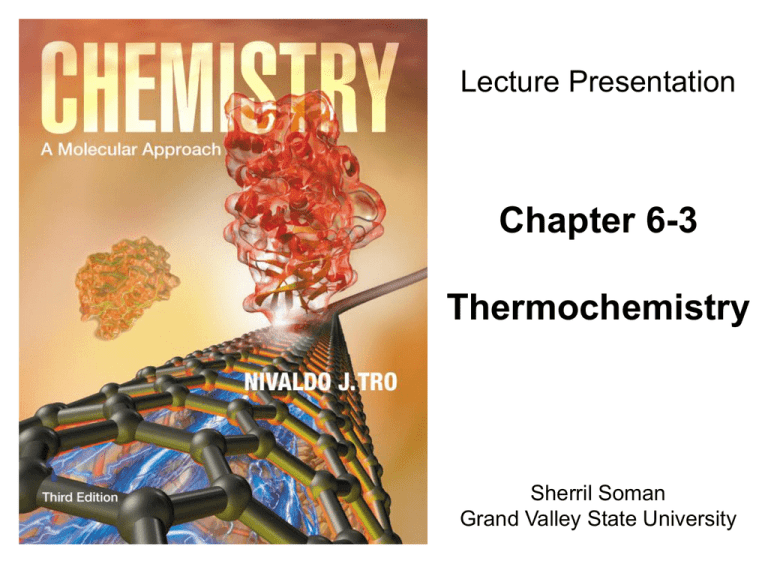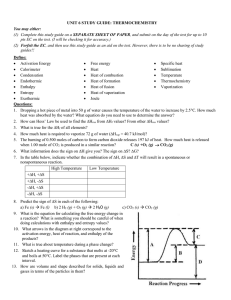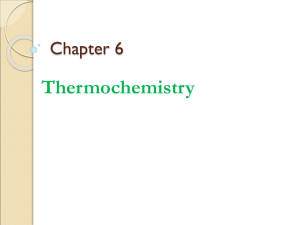DH - Delaware State University
advertisement

Lecture Presentation Chapter 6-3 Thermochemistry Sherril Soman Grand Valley State University Bomb Calorimeter • It is used to measure DE because it is a constant volume system. • The heat capacity of the calorimeter is the amount of heat absorbed by the calorimeter for each degree rise in temperature and is called the calorimeter constant. – Ccal, kJ/ºC Enthalpy • The enthalpy, H, of a system is the sum of the internal energy of the system and the product of pressure and volume. – H is a state function H = E + PV • The enthalpy change, DH, of a reaction is the heat evolved in a reaction at constant pressure. DHreaction = qreaction at constant pressure • Usually DH and DE are similar in value; the difference is largest for reactions that produce or use large quantities of gas. Endothermic and Exothermic Reactions • When DH is negative, heat is being released by the system. – This is called an exothermic reaction. • When DH is positive, heat is being absorbed by the system. – This is called an endothermic reaction. Endothermic and Exothermic Reactions • Chemical heat packs contain iron filings that are oxidized in an exothermic reaction—your hands get warm because the released heat of the reaction is transferred to your hands. • Chemical cold packs contain NH4NO3 that dissolves in water in an endothermic process—your hands get cold because the pack is absorbing your heat. Molecular View of Exothermic Reactions • For an exothermic reaction, the surrounding’s temperature rises due to a release of thermal energy by the reaction. • This extra thermal energy comes from the conversion of some of the chemical potential energy in the reactants into kinetic energy in the form of heat. • During the course of a reaction, existing bonds are broken and new bonds are made. • The products of the reaction have less chemical potential energy than the reactants. • The difference in energy is released as heat. Molecular View of Endothermic Reactions • In an endothermic reaction, the surrounding’s temperature drops due to absorption of some of its thermal energy by the reaction. • During the course of a reaction, existing bonds are broken and new bonds are made. • The products of the reaction have more chemical potential energy than the reactants. • To acquire this extra energy, some of the thermal energy of the surroundings is converted into chemical potential energy stored in the products. Enthalpy of Reaction • The enthalpy change in a chemical reaction is an extensive property. – The more reactants you use, the larger the enthalpy change. • By convention, we calculate the enthalpy change for the number of moles of reactants in the reaction as written. C3H8(g) + 5 O2(g) → 3 CO2(g) + 4 H2O(g) DH = −2044 kJ 1 mol C3H8(g) = –2044 kJ or 5 mol O2(g) = –2044 kJ Measuring DH Calorimetry at Constant Pressure • Reactions done in aqueous solution are at constant pressure. – Open to the atmosphere • The calorimeter is often nested foam cups containing the solution. qreaction = ─ qsolution = ─(masssolution × Cs, solution × DT) DHreaction = qconstant pressure = qreaction – To get DHreaction per mol, divide by the number of moles. Relationships Involving DHrxn • When reaction is multiplied by a factor, DHrxn is multiplied by that factor. – Because DHrxn is extensive, C(s) + O2(g) → CO2(g) DH = −393.5 kJ 2 C(s) + 2 O2(g) → 2 CO2(g) DH = 2(−393.5 kJ) = −787.0 kJ. • If a reaction is reversed, then the sign of DH is changed. CO2(g) → C(s) + O2(g) DH = +393.5 kJ Relationships Involving DHrxn Hess’s Law • If a reaction can be expressed as a series of steps, then the DHrxn for the overall reaction is the sum of the heats of reaction for each step. Standard Conditions • The standard state is the state of a material at a defined set of conditions. – Pure gas at exactly 1 atm pressure – Pure solid or liquid in its most stable form at exactly 1 atm pressure and temperature of interest • Usually 25 °C – Substance in a solution with concentration 1 M • The standard enthalpy change, DH°, is the enthalpy change when all reactants and products are in their standard states. • The standard enthalpy of formation, DHf°, is the enthalpy change for the reaction forming 1 mole of a pure compound from its constituent elements. – The elements must be in their standard states. – The DHf° for a pure element in its standard state = 0 kJ/mol. Standard Enthalpies of Formation Formation Reactions • Reactions of elements in their standard state to form 1 mole of a pure compound. – if you are not sure what the standard state of an element is, find the form in Appendix IIB that has DHf°= 0. – Because the definition requires 1 mole of compound be made, the coefficients of the reactants may be fractions. • Writing Formation Reactions: Write the Formation Reaction for The formation reaction isCO(g) the reaction between the elements in the compound, which are C and O. C + O → CO(g) • The elements must be in their standard state. – There are several forms of solid C, but the one with DHf° = 0 is graphite. – Oxygen’s standard state is the diatomic gas. C(s, graphite) + O2(g) → CO(g) • The equation must be balanced, but the coefficient of the product compound must be 1. – Use whatever coefficient in front of the reactants is necessary to make the atoms on both sides equal without changing the product coefficient. C(s, graphite) + ½ O2(g) → CO(g) Calculating Standard Enthalpy Change for a Reaction • Any reaction can be written as the sum of formation reactions (or the reverse of formation reactions) for the reactants and products. • The DH° for the reaction is then the sum of the DHf° for the component reactions. DH°reaction = S n DHf°(products) − S n DHf°(reactants) S means sum. n is the coefficient of the reaction. CH4(g)+ 2 O2(g)→ CO2(g) + H2O(g) C(s, graphite) + 2 H2(g) → CH4(g) DHf° = − 74.6 kJ/mol CH4 C(s, graphite) + O2(g) → CO2(g) DHf° = −393.5 kJ/mol CO2 H2(g) + ½ O2(g) → H2O(g) DHf° = −241.8 kJ/mol H2O CH4(g)+ 2 O2(g)→ CO2(g) + H2O(g) CH4(g) → C(s, graphite) + 2 H2(g) C(s, graphite) + O2(g) → CO2(g) 2 H2(g) + O2(g) → 2 H2O(g) D H° = + 74.6 kJ DHf° = −393.5 kJ/mol CO2 DH°= −483.6 kJ CH4(g) + 2 O2(g) → CO2(g) + 2 H2O(g) DH°= −802.5 kJ CH4(g)+ 2 O2(g)→ CO2(g) + H2O(g) DH°= [((−393.5 kJ)+ 2(−241.8 kJ)− ((−74.6 kJ)+ 2(0 kJ))] = −802.5 kJ DH°= [(DHf°CO2(g) + 2 ∙ DHf°H2O(g)) − (DHf°CH4(g) + 2 ∙ DHf°O2(g))] CH4(g) + 2 O2(g) → CO2(g) + 2 H2O(g) DH°= −802.5 kJ Energy Use and the Environment • In the United States, each person uses over 105 kWh of energy per year. • Most comes from the combustion of fossil fuels. – Combustible materials that originate from ancient life. C(s) + O2(g) → CO2(g) DH°rxn = −393.5 kJ CH4(g) +2 O2(g) → CO2(g) + 2 H2O(g) DH°rxn = −802.3 kJ C8H18(g) +12.5 O2(g) → 8 CO2(g) + 9 H2O(g) DH°rxn = −5074.1 kJ Energy Use and the Environment • Fossil fuels cannot be replenished. • At current rates of consumption, oil and natural gas supplies will be depleted in 50–100 years. Energy Consumption The Effect of Combustion Products on Our Environment • Because of additives and impurities in the fossil fuel, incomplete combustion, and side reactions, harmful materials are added to the atmosphere when fossil fuels are burned for energy. • Therefore, fossil fuel emissions contribute to air pollution, acid rain, and global warming. • Global Warming CO is a greenhouse gas. 2 – It allows light from the sun to reach Earth, but does not allow the heat (infrared light) reflected off Earth to escape into outer space. • It acts like a blanket. • CO2 levels in the atmosphere have been steadily increasing. • Current observations suggest that the average global air temperature has risen 0.6 °C in the past 100 years. • Atmospheric models suggest that the warming effect could worsen if CO2 levels are not curbed. • Some models predict that the result will be more severe storms, more floods and droughts, shifts in agricultural zones, rising sea levels, and changes in habitats. • Global Warming CO is a greenhouse gas. 2 – It allows light from the sun to reach Earth, but does not allow the heat (infrared light) reflected off Earth to escape into outer space. • It acts like a blanket. • CO2 levels in the atmosphere have been steadily increasing. • Current observations suggest that the average global air temperature has risen 0.6 °C in the past 100 years. Renewable Energy • Our greatest unlimited supply of energy is the sun. • New technologies are being developed to capture the energy of sunlight. – Parabolic troughs, solar power towers, and dish engines concentrate the sun’s light to generate electricity. – Solar energy is used to decompose water into H2(g) and O2(g); the H2 can then be used by fuel cells to generate electricity. H2(g) + ½ O2(g) → H2O(l) DH°rxn = −285.8 kJ Renewable Energy • Hydroelectric power • Wind power






